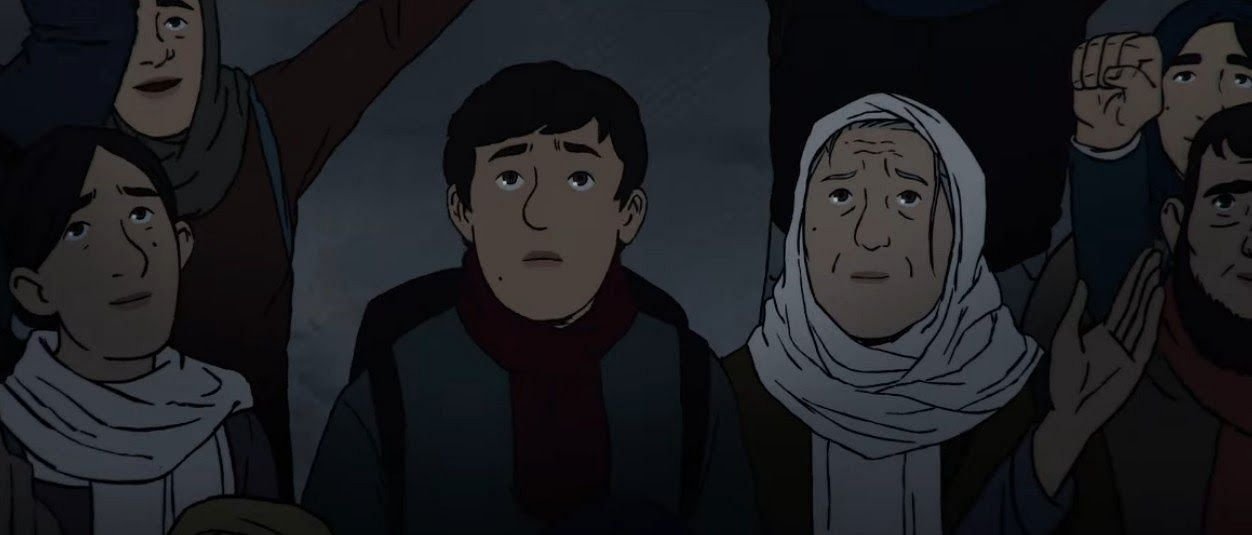FLEE
Directing: A
Writing: A
Cinematography: B+
Editing: A
Animation: B+
Flee has to be seen to be believed. Or perhaps more accurately, seen to broaden your mind, about refugees, about people from Afghanistan, about the tumultuous modern history of Afghanistan, about the human experience. This is a window into a world and a past that puts the privilege of citizens of the Western World into sharp relief.
it’s also a uniquely incredible cinematic achievement. Flee is the first film ever eligible for an Oscar simultaneously in the Documentary, Animation and International Feature categories. Not since the incredible 2008 film Waltz with Bashir have I been so taken with and moved by an animated documentary film. I have to admit, that film was more immediately stunning on a visual level, helping render it both hypnotic and transporting. Flee, on the other hand, uses comparatively rudimentary animation in effectively specific, emotional ways. We left this movie in stunned silence.
The conceit of Flee is that Danish director and co-writer Jonas Poher Rasmussen interviews Afghanistan-born Amin Nawabi (who is also credited as co-writer) about his extraordinary life story, which he has not told a soul in his country of residence—Denmark—until now. Even when he begins referring to his story and his childhood, he casually references details that are later revealed to be part of the elaborate lie he told everyone in order to protect the family that actually did survive: that Afghan militants killed both his father and his mother, and kidnapped his sister. This was the story he concocted at the behest of the last in a series of human traffickers attempting to get him out of Russia and into Sweden. This after multiple unfortunate detours through Russia and, in one six-month period, Estonia.
Amin is not this man’s real name. The animation reportedly alters his appearance as well, which lends another layer to the choice of animation for this film. Many times throughout the film, Rasmussen switches to archival video footage. But, any time we see Amin and his family, whether in the present day or in the many flashbacks, they are animated. This is less an attempt at artistic flourish as it is a strangely comforting means of obscuring the vividness of Amin’s reality.
His extended traumas of childhood affect his relationships today. It feels like it was one of his few strokes of luck that he landed in a Scandinavian country, with its comparatively tolerant and permissive cultural attitudes. One top of all Amin’s family stresses, the kind of which most Americans can’t even fathom, Amin also turns out to be gay. There is an extended sequence after Amin finally confesses to his older brother and sisters in Sweden that he’s not interested in women, which, particularly if you’re also gay (like me) or queer, packs an acutely emotional wallop. It also bucks the stereotype of people from sexually repressed Muslim cultures.
Curiously, Amin never discusses religion in Flee, in spite of its massive influence on all of Afghanistan’s history. When it comes to Amin’s fears about the revelation of his sexuality, he doesn’t discuss any fear of God, but only the fear of being rejected by a family who had sacrificed so much for him to get the chance of a better life. His much older brother, who worked as a janitor in Sweden and scraped enough savings to attempt smuggling his family out of Russia, is ultimately supportive in a way many queer kids, even in America, can only dream of. There’s a scene where young Amin visits a gay bar for the first time, and I could only imagine that the un-self-conscious freedom on display was both intimidating and disorienting.
As for present-day Amin, there doesn’t seem to be any lingering issues with accepting his sexuality. Instead, his lingering issues have to do with how his traumas become road blocks to a healthy relationship with his current partner, who has never heard any of this backstory, and can only guess at the underlying cause of some of his subtly frustrating behaviors.
Flee is the kind of movie that not nearly enough people will watch, but which everyone should see. It’s great on a big screen in a theater, but luckily it’s also currently available on VOD for about six bucks. It’s undervalued. The idea that it reveals a dramatic story largely unrealized by xenophobic bigots, who might gain some understanding and compassion for immigrants and especially refugees, is the tip of the iceberg. This is a true story with plot twists that rival the most suspenseful of narrative feature films. It’s a literal illustration of resilience, as well as the lasting effects of deep trauma. This film is an experience I will not soon forget.
Amin and his mother, facing another in a llong ine of false promises
Overall: A

